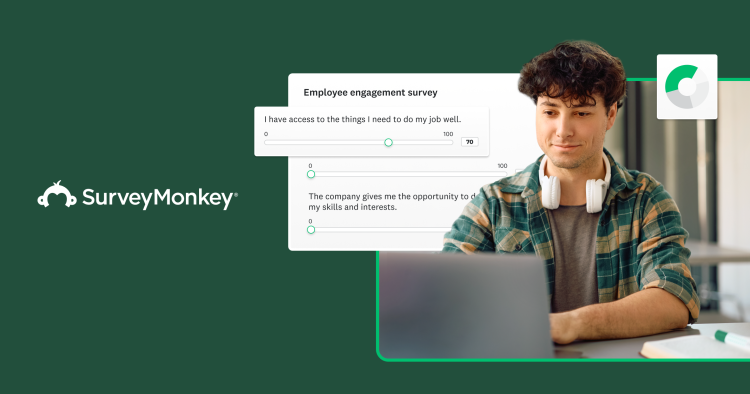The ultimate guide to Customer Satisfaction Score
Customer Satisfaction Score (CSAT) is a customer loyalty metric companies use to gauge customer satisfaction with interactions or overall experiences.
CSAT is among the top three loyalty metrics, alongside Net Promoter Score® (NPS) and Customer Effort Score (CES), that contribute to a successful Voice of the Customer (VoC) program.
While satisfaction is only one component of a successful CX program, it’s a very important one. By setting the right goals and implementing effective strategies, CSAT can be an invaluable customer loyalty metric.
Why CSAT is important

Customer satisfaction and excellent customer experiences are closely intertwined. Creating an engaging customer experience ensures you satisfy customers at every touchpoint.
In fact, 62% of marketing ecommerce professionals expect their company to focus more on customer engagement in 2023. Especially in times of economic downturn, a further 72% of ecommerce professionals believe that prioritizing customer engagement is vital for success.
However, businesses need to provide a streamlined, engaging, and enjoyable experience to increase customer satisfaction.
How to measure your customer satisfaction score

To measure your customer satisfaction score, ask customers to rate their overall experience with your brand. The wording isn’t critical as long as the question is straightforward.
Regardless of your language, you should always give customers the ability to respond on a five-point scale. Typical options include: very unsatisfied, unsatisfied, neutral, satisfied, and very satisfied. You can also include space for customers to leave additional comments and context.
Once you’ve collected feedback via your customer satisfaction survey, you can calculate your CSAT score in two ways.
While you can calculate the average of all scores, we suggest you focus on the percentage of those customers who consider themselves satisfied (the 4-5 scores). Divide the total number of customers who selected very satisfied (5) or satisfied (4) by the total number of responses and multiply that by 100.
This figure will give you the percentage of happy customers rather than a general happiness average.
CSAT industry benchmarks

If you’re new to CSAT and customer satisfaction surveys, a good starting point is seeing how you compare to peers in your industry. To do so, you can use the American Customer Satisfaction Index (ACSI).
The ACSI is the only national economic indicator that measures customer satisfaction across the US economy. According to the ACSI, 2022/2023, the overall US Customer Satisfaction Score is 75.53%. However, CSAT varies by industry.
- Airlines: 76% (2023)
- Banks: 78% (2022)
- Car Rentals: 76% (2023)
- Computer Software: 78% (2022)
- Drugstores: 76% (2023)
- Energy Utilities: 72% (2023)
- Fast Food Restaurants: 76% (2022)
- Federal Government: 66% (2022)
- Full-Service Restaurants: 80% (2022)
- Health Insurance: 73% (2022)
- Hospitals: 71% (2022)
- Hotels: 75% (2023)
- Internet Service Providers: 64% (2022)
- Life Insurance: 78% (2022)
- Online Retailers: 80% (2023)
- Social media: 71% (2022)
- Supermarkets: 76% (2023)
- U.S Postal Service: 70% (2023)
- Video Streaming Services: 74% (2022)
- Wireless Phone Service: 74% (2023)
If you want to see quarterly benchmark updates, visit the ACSI website.
If your industry isn’t listed on the ACSI, comparing your business to the overall US customer satisfaction score of 75.53% is a good starting point.
While it helps to know where you stand relative to your peers, the key to success is to focus on improving. Your customers’ expectations are not necessarily set by what your industry does. Trends, competitors, and expectations change.
How to use the CSAT metric

It’s important to recognize that improving CX isn’t solely about measuring satisfaction—it’s about taking action based on the insights you gain from those measurements. However, you must start by setting strategic and realistic goals.
First, set goals for your CSAT metric
Goal 1: Measure a specific experience point
CSAT can provide insights into how well your brand met expectations at key parts of the customer journey, such as purchasing, onboarding, support calls, etc.
This type of interaction is often measured and included in Customer Experience Management. You can use CSAT score to address issues with an individual customer and in your organization's overall Voice of the Customer program.
Goal 2: Coach employees
Measuring CSAT after a store visit, support call, or live chat may provide specific feedback to address with employees. Using this to coach employees and share how to improve their feedback will help improve the experience for future customers.
Goal 3: Seek satisfaction feedback periodically
Providing a periodic satisfaction survey to customers can allow them to share immediate concerns and gather feedback not necessarily related to a specific step in the journey.
It can be challenging to determine what to do if the results are not as positive as expected. But if you are beginning to explore customer feedback in general, this is a simple way to start.
CSAT as a relationship survey
Companies typically conduct relationship surveys at least annually to assess how customers perceive the organization and the products, services, and support delivered. Like NPS, you can use the Customer Satisfaction Score (CSAT) for relationship surveys.
Companies should add diagnostic questions about product quality, service responsiveness, etc. In addition to the main 1-5 loyalty question, it’s a good idea to ask at least one open-ended question to give customers a chance to explain their ratings or to share issues not represented in the survey.
CSAT as a touchpoint survey
You can use touchpoint surveys to capture feedback after individual customer interactions with different parts of the company. Touchpoint surveys should be as short as possible to maximize the response rate. Its goal is to understand how well a brand performed at a particular point in the customer journey.
Here’s an example of how to use CSAT as a touchpoint survey: A pop-up web survey can get feedback as customers or prospects interact with a website. Following service interactions is another excellent opportunity to ask for feedback, ideally on the same channel the customer previously engaged with.
A CSAT survey may identify customers who feel your payment invoices are overly complex and difficult to understand. Use feedback, along with what they share in the open text field, to create an action plan for improving the clarity of the invoice.
Once you roll out those changes, measure CSAT around the touchpoint again. You can use this approach for any touchpoint you identify as a customer pain point.
Examples of customer satisfaction questions to use in a CSAT survey
The success of your customer satisfaction survey depends on asking the right questions in the right way. Otherwise, the data and insights you gather won’t be as accurate or valuable. With these ten examples of customer satisfaction survey questions for various use cases, you can design the most effective survey for your needs.
How satisfied are you with our onboarding experience?
Gaining a new customer is exciting. But if you’re in an industry where an onboarding experience is required (for a B2B software product, for example), frustrations with the customer experience can start early. Asking your customers about their satisfaction with the onboarding process can surface any pain points you should fix so your customer experience starts on the right foot.
How would you rate your overall satisfaction with the event you recently attended?
After you put on an event or conference, whether online or in person, gathering feedback from attendees is important. If they were dissatisfied with a part of the event—or the whole thing—they’re not likely to attend again or to recommend that others do so. Sending a customer satisfaction event survey right after the event will help you measure if your event lived up to their expectations and learn how to improve for next time.
How satisfied are you with your recent experience on our website?
Developing a functional, beautiful website for your business is no small task. You want to gather customer feedback after the site launches or make significant changes to ensure your online experience is satisfying instead of frustrating. You could also add a further question about their experience, like asking if they could find everything they needed during their website visit.
How would you rate your satisfaction with your recent online purchase experience?
Consumers these days expect a seamless, nearly effortless online shopping experience from companies. Are you living up to that expectation, or is your online checkout and purchase experience full of pain points? These pain points can cause people who are about to become customers to give up and go to a competitor, so asking about satisfaction levels during this part of the customer journey can yield significant improvements for your business.
How satisfied are you with your recent customer support experience?
This is one of several potential customer service survey questions you can ask respondents after they contact your customer support team with an issue or a question. Having a team that offers quick, practical help to customers when a problem arises is vital to their overall satisfaction levels. After all, customers don’t expect that issues will never come up, but they do expect that when one does, your company will offer them help promptly and efficiently.
How would you rate your overall satisfaction with [company]?
Customer feedback survey questions don’t always need to ask about a specific and recent customer experience—you can use them to gather feedback about overall satisfaction levels with your company. This question can help you measure customers' feelings about your company, considering all their transactions and interactions with you. It’s best followed up with an open-ended question that asks what could improve their satisfaction rates if they’re low or why they rated your products or services highly.
What’s working for you and why?
Using skip logic is an excellent idea for some customer satisfaction surveys. That way, you can ask satisfied customers different open-ended questions than those who are not. Asking happy customers what works for them—and why—can help you identify things your company is doing well in the customer journey. You can then build on those successes and use those selling points in your marketing and sales process.
What can our employees do better?
Your employees are a vital part of your customer experience—many contact customers daily. Asking customers who have indicated that they’re dissatisfied to tell you in their own words what your employees could improve upon might surface some unexpected issues in the customer experience.
What is one thing we could do to improve your experience with [company]?
This is another great open-ended question to ask people who have rated themselves as dissatisfied. Various factors may go into their dissatisfaction, but identifying the most important one can help you find challenges in your customer experience. Then you can work on fixing them and watch your CSAT scores rise.
Do you have any additional comments or feedback for us?
Offering an entirely open-ended question option lets customers tell you everything they think about their experiences with your business.
You can use this question when you want to provide a wide-open field for their thoughts without any guidance as to topics.
Take action on CSAT feedback

You’ve identified the best approach to using CSAT and sent out a survey. Now the feedback is pouring in. Excellent, you’ve met your first goal of collecting fresh and relevant data.
While receiving feedback is good, it can also be overwhelming because it means sorting through all the feedback to turn it into actionable insight.
Having a process mapped out for you is always helpful. Complete the following steps to transform, consume, and operationalize your survey data.
Step 1: Set up service recovery
First, you should create alerts for feedback that allow the appropriate team member to follow up with the customer.
To plan, ask yourself:
- Who will respond to the customer, and within what time?
- How will they respond (by phone, email, or in person)?
- What information do they need to make the call?
- What is the intended outcome of the follow-up?
- When and how does the service recovery get escalated?
Respond to both negative and positive feedback. When customers provide positive feedback or mention specific employees and a job well done, that feedback should go to the appropriate teams or people. You can also automate feedback distribution if you’re looking to optimize further.
Step 2: Prepare an analysis plan
Before you analyze your feedback, you need to develop your analysis plan, which is a roadmap for analyzing your data and why you’re studying it.
Here’s what the plan should include:
- Objectives and goals of the survey
- The questions you’re trying to answer
- Any issues you’re looking to address
- Data sources (survey data, customer data, populations)
- Data segmentation
Think about the types of analysis you’ll need to conduct to tease out the story from the data, how you want to prepare it, and how you want to present it.
- How to handle missing values (and other data rules)
- Key outcomes (dependent variables)
- Inputs (independent variables)
- Statistical, predictive, prescriptive, and descriptive analysis to-dos
- Deliverables (e.g., reports, presentations, spreadsheets, etc.)
- QA requirements
Step 3: Analyze the data
Break down the customer feedback so that you can understand it better.
Do a crosstab, identify key drivers, and prioritize improvements with survey data; mine and analyze your unstructured data; and conduct linkage analysis to link customer and employee data, customer feedback with operational metrics, and all data to financial measures.
And finally, you must conduct a root cause analysis to understand why data appears a certain way. Put all the analysis pieces together to tell a story, developing additional context for those who need to act on it.
If you’re one of the 53% of organizations that are experiencing slowing growth, focusing on root cause analysis and mitigation can radically improve your customer experience.
Step 4: Socialize both data and insights
You should share the insights with those teams or departments with a vested interest in the specific feedback. It must also find its way into the hands of your executives.
Some improvements may require C-level involvement to ensure the commitment is there for time, funds, and other resources.
Step 5: Strategize a plan for taking action
Before you take action, you must plan for it. Ask yourself these questions:
- What are some of the common issues, themes, or trends that arise from the data?
- How will the department respond to these insights?
- What improvements do they need to make to their specific policies and processes?
- What communication ensures the entire team or department is on board with the required changes?
This is a critical step to turn insights into action. Asking yourself what you will do, how you will do it, and who will take responsibility will guide this step.
Step 6: Take action on the feedback
With a plan, you’re ready to implement the necessary changes.
For example, if you find out that a product feature is faulty, you’ve got to prototype the fix, test it with customers, and collect feedback again.
If customers say the experience is still problematic, repeat the process. Let customers be your guide as to whether something becomes a better experience. Once you’ve implemented the new or improved experience, train employees on new tools or processes that facilitate the experience.
Finally, let customers know what you’ve done and your continued plan for improvement.
Improve a poor CSAT score

If you’re not satisfied with your CSAT score, don’t get discouraged. There are plenty of ways to tackle the problem and see better results.
Here are some basic, but necessary, steps to consider.
Take immediate action on feedback
Show your customers you’re listening by responding to their feedback. Going that extra mile will make your customers feel heard.
For positive feedback, a simple personalized thank you note is sufficient. Alternatively, If the feedback is negative, the program owner or the correct stakeholder should engage with the customer with follow-up questions.
Capture customer feedback at the right time
It’s impossible to improve customer satisfaction without feedback. One way to increase response rates is by sending your CSAT survey at the right time. Although this varies by circumstance, the general best practice is sending a survey within a few days of purchase or deal completion.
Audit internal factors for pain points
Many internal and operational factors could lead to your customers’ dissatisfaction. It’s essential to consider all of them—including everything from website design, customer service, and company culture.
For instance, ensure you optimize your website’s design for ease of use. The last thing you want is a potential customer to leave your site due to a poor experience.
Audit external factors for pain points
Many external factors influence your CSAT score. Among the many elements to consider, you must ensure consistency in brand quality, ease of use, and a truly omnichannel experience.
Modern customers expect the ability to engage with a company across all communication channels seamlessly. The ability to share feedback across multiple channels gives your customers a voice.
Fix the pain points in your customer journey
Mapping the customer journey helps you understand the current customer experience, including challenges and advantages. And, considering that 48% of leaders say a strong customer experience gives them confidence, your business should strive for excellence when dealing with consumers.
CSAT surveys are a great tool to identify the key issues you must fix to optimize satisfaction. Once you’ve made improvements, measure those touchpoints again, and repeat.
Empower your employees
You can use the CSAT metric to measure customer satisfaction after specific interactions with a company’s employees, especially support agents.
The feedback will allow you to coach your teams so they’re better prepared to meet expectations and overcome common complaints, like representatives lacking the knowledge or ability to solve customer issues.
Open up more support channels
Open up new channels for your customers, like SMS or live chat, to serve them as quickly as possible. Direct support channels also allow you to apologize to consumers if something goes wrong, which is the first step toward remedying the problem.
Make your CSAT rating even better

Even if you have an excellent CSAT score—one that is equal to or above the industry average—there is always room for improvement.
Given your doing well, it’s safe to assume you’re already taking the basic steps of strategically collecting and responding to CSAT surveys. So, we’ll skip over those recommendations and provide additional ways to improve your Customer Satisfaction Score (CSAT).
Here’s what we suggest.
Design a customer-centric culture
Do your core values speak to putting people first? Being customer-centric means the customer is at the heart of everything you do.
Before every decision you make, every product or process you design, and everything you do, pause to ask: “How will this impact the customer?” and “How will this make them feel?”
Focus on the employee experience
Consider the employee experience. Without employees, you have no customer experience. You must ensure that you listen to employees and improve their experience.
Determine whether they have the tools, resources, and processes to serve the customer how they deserve or desire.
Our research showed that 45% of ecommerce professionals say that access to tools is vital to the success of their job. If you support your employees, they’ll be able to give your customers the best possible experience.
Review and refresh your Voice of the Customer program
As all of the changes noted earlier happen, the surveys must also evolve to capture feedback about updates in your business or industry.
Also, data collection methods have changed. Respondent preferences for completing surveys and when and where to provide feedback have changed. The Voice of the Customer has changed and includes more than just surveys.
There are a lot of things that change over time, but if your approach to your VoC program—not just the way you capture feedback but also the way you distribute, analyze, act on it, and communicate improvements—has remained stagnant, you’re not only wasting money, you’re doing your customers and your business a huge disservice.
Go beyond basic analytics
Take a look at your analysis toolbox and go beyond simple descriptive analytics and quadrant charts.
Use predictive and prescriptive analytics to identify the next best action to ensure the customer achieves her desired outcome, how much effort to put forth, and the impact on the customer and the business.
Root cause analysis
You should conduct a root cause analysis on any issues or pain points your customers' experience.
You only provide a temporary solution if you make improvements superficially or cosmetically. If you find the root cause of the issue, fix that, and design a better customer experience, your customers will see the benefits.
Provide short tutorials for your customers
A product or feature can disappoint a customer because it’s not as user-friendly as they’d like. In addition to using this feedback to optimize your product or feature, establish a tutorial plan for your customers. This includes anything from short video tutorials to employees setting up one-on-one customer meetings.
Prove the ROI of customer satisfaction

The process for proving the return on investment on CSAT is not an exact science. You have to determine what a one-point increase in your Customer Satisfaction Score (CSAT) is worth regarding revenue impact.
Let’s say that our made-up pet store, BarkTalk, sends out a case-closed CSAT survey to 10,000 customers and receives 1,000 responses. Of those responses, 600 customers scored their experience a 4 or 5. As for the rest, 200 customers scored a 3, and the remaining 200 scored a 1 or 2.
The first step for BarkTalk is to calculate their CSAT score.
The formula is: (Total 4-5 responses) / (Total responses) x 100 = CSAT score
So, for this case, the math would be: 600 / 1,000 x 100 = 60%
Next, BarkTalk needs to estimate the potential revenue it could save if they implement new CX initiatives and improve its CSAT score by just one point. For this example, let’s assume the average spend per customer is $500 (if you’re a B2B business, this is the equivalent of your average deal size).
The calculation below uses the average churn rate we’ve derived via research.
| 200 customers who rated 1-2 (92% will churn) | 184 customers will churn |
| 200 customers who rated 3 (80% will churn) | 160 will churn |
| Total revenue lost ($500 x 184 + 160) | $170,000 |
The math above reveals that BarkTalk lost 344 customers. That’s 344 customers who could have returned and, in total, would have spent $170,000 per year. But let’s say there is a trend with the customers who rated BarkTalk a 1 or 2: The majority noted in the survey that the wait on customer service live chat was too long.
So BarkTalk takes the necessary measures to optimize its live chat services. Enough so that when they send out their new batch of the case closed CSAT survey, they see their 1-2 rating decreased, while their 4-5 increased.
Here are the new scores:
- Total responses: 1,000
- Customers rating 4-5: 700
- Customers rating 3: 200
- Customers rating 1-2: 100
Their CSAT score has increased to 70%.
Let’s apply the same calculation above to the new data to see the impact of a 10% increase in their CSAT score.
| 100 customers who rated 1-2 (92% will churn) | 92 customers will churn |
| 200 customers who rated 3 (80% will churn) | 160 will churn |
| Total revenue lost ($500 x 160 + 92) | $126,000 |
| Total revenue you save with a 10% increase | $44,000 ($170,000-$126,000) |
By increasing its CSAT score by just 10%, BarkTalk could save $44,000 annually.
Foster long-term loyalty with CSAT
CSAT is a valuable metric that allows businesses to assess customer satisfaction and improve customer loyalty. While it’s only a part of developing a successful customer experience, CSAT plays a crucial role in creating engaging customer experiences and fostering long-term customer relationships.
Explore more survey options and discover how to put customers at the center of your business with SurveyMonkey.
Your best customers are the ones you already have
Identify and address customer pain points, boost CSAT scores, and drive revenue growth with SurveyMonkey.
Net promoter, Net promoter Score, and NPS are trademarks of Satmetrix Systems, Inc., Bain & Company, Inc., and Fred Reichheld.


